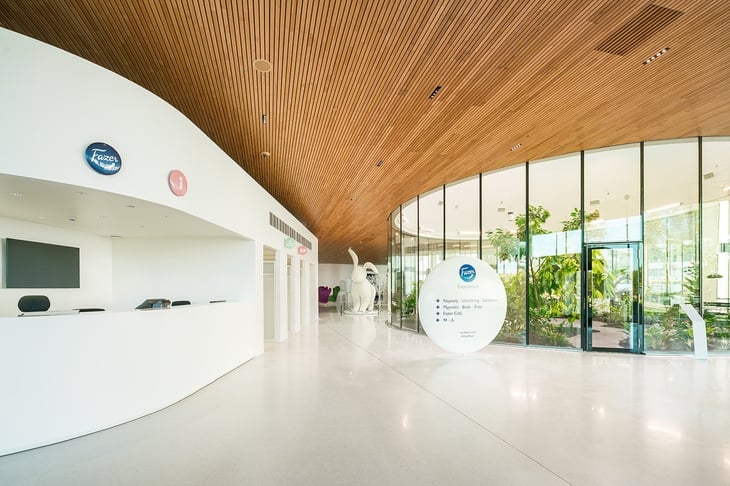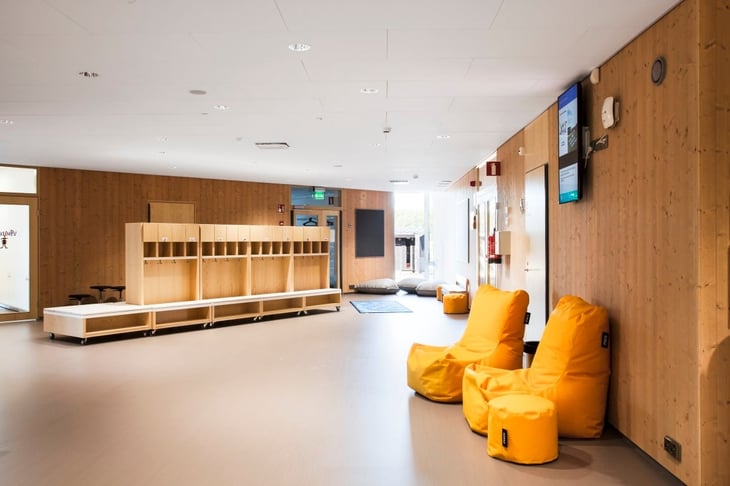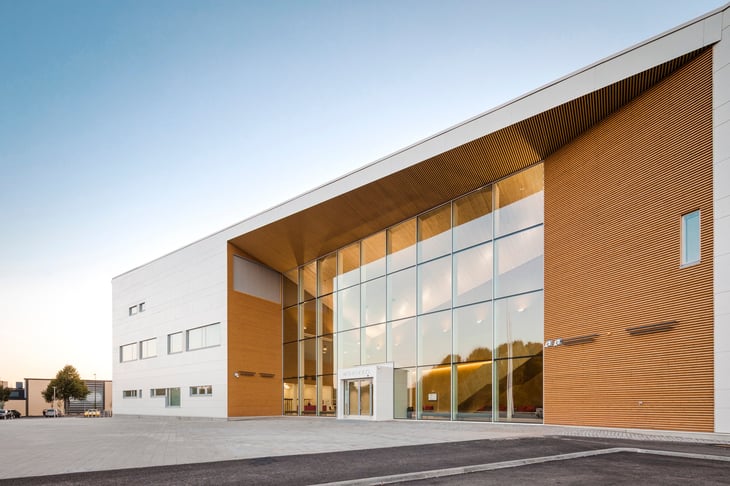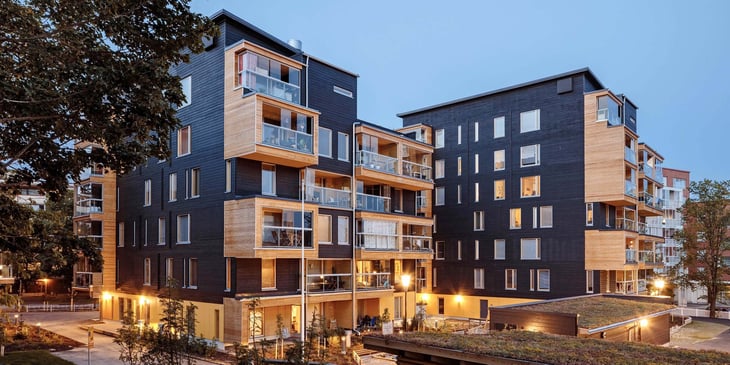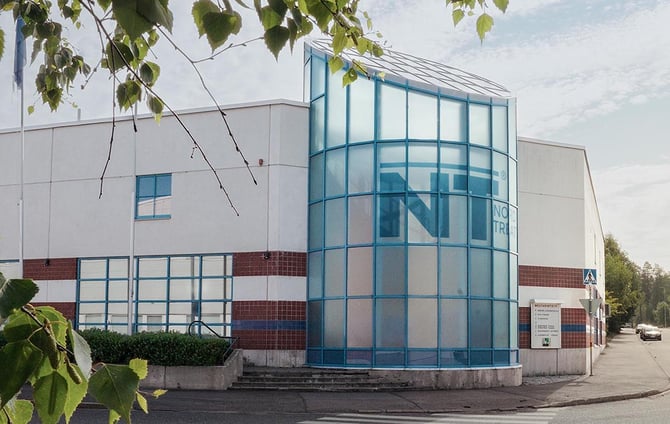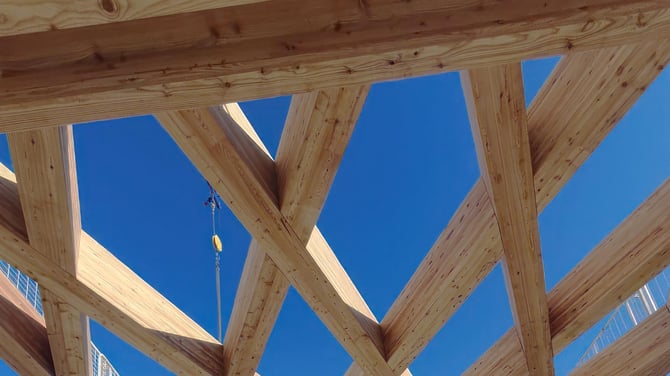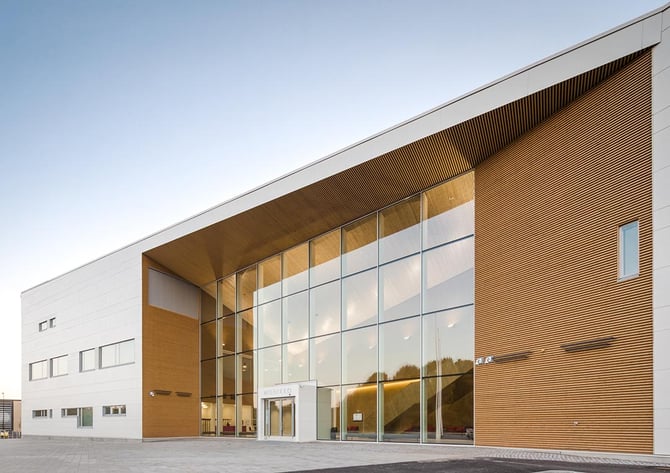1. FIRE PROTECTION FOR WOOD BUILDINGS
Environmental values influence the objectives and regulation of construction. The rapid development of ecological wood products as well as the development of in terms of hybrid construction using different materials has enabled many countries to change their building regulations, allowing for taller buildings to be built with timber frames.
Wood is a fire-safe building material because its behaviour in fires is well known. A timber frame building can withstand a fire for a long time without collapsing because the charring of surfaces protects the structures from the fire. The tallest timber frame building in the world in 2019 is the 18-storey Mjøstårnet in Brumunddal, Norway.
READ MORE ABOUT THE DEVELOPMENT OF TIMBER CONSTRUCTION →
2. FIRE PROTECTION REQUIREMENTS FOR WOOD
The primary concern in fire protection is that the solution is compliant with building regulation requirements. Other key aspects are related to visual options, durability, health considerations and environmental safety. The solution must also be economical in terms of the cost-benefit ratio.
The fire safety standards for wood buildings are high according to international, national and local building regulations. In Europe, the European construction standards form the core of the requirements. Eurocode 5 describes how to design wood buildings with timber in solid, sawn, planed or in pole form, glue laminated timber or wood-based structural products, (e.g. LVL and CLT) or wood-based panels. This includes also structural fire design regulations.
The individual fire protection requirements, for example, which part of a building has to consist of what type of material with regards to fire, are set up individually in the national building codes As there are many different regulations in Europe, even local ones per member state, we recommend checking with the local building authorities in your country about the use of wood products in construction and their protection with flame retardants.
WOOD PRODUCT FIRE TESTING
The fire behaviour of construction materials is tested in different ways already during product development. In Europe, the regulatory fire classification is carried out on all construction products, including wood products, according to standard SFS-EN 13501-1 + A1 with Euroclass system-compliant tests. Testing is carried out by an accredited commercial testing laboratory.
READ MORE ABOUT THE FIRE TESTING OF WOOD PRODUCTS →
THE EUROCLASS SYSTEM
The European fire testing of construction products is based on the Euroclass system with the following standardised tests:
1. Fire technical testing of building products – non combustibility: EN ISO 1182
2. Fire technical testing of building products – single burning item test (SBI): EN 13823
3. Fire technical testing of building products – ignitability test: EN ISO 11925-2
As an example, wood products treated with Nordtreat flame retardants fulfil Euroclass B-s1,d0. This means that the products contribute to the fire to a very limited extent, their smoke production is very limited and no flaming droplets occur. Euroclass requirements for building materials are A1, A2, B, C, D, E and F. Smoke production and the formation of flaming droplets are expressed with the additional classes s and d. The smoke production classes are s1, s2 and s3, and the formation of flaming droplet classes are 0, d1 and d2.
THE EUROCLASS CLASSES INDICATE THE FOLLOWING FEATURES:
A1 Products will not contribute at all to the fire.
A2 Products will contribute in the fire to an extremely limited extent.
B Products will contribute in the fire to a very limited extent.
C Products will contribute in the fire to a limited extent.
D Products will contribute in the fire to an acceptable extent.
E Products’ reaction to fire performance is acceptable.
F No reaction to fire performance is determined.
s1 The smoke production is very limited.
s2 The smoke production is limited.
s3 The smoke production does not meet the requirements of class s1 or s2.
d0 No flaming droplets or particles occur.
d1 The flaming droplets or particles extinguish quickly.
d2 The formation of flaming droplets or particles does not meet the requirements of class d0 or d1.
FIRE CLASS B-S1, D0 WOOD PRODUCT APPLICATIONS
Buildings are in most European countries divided according to purpose, frame and fire-separating elements into different building classes. The building fire class, number of storeys and wood product applications usually determine the Euro class, with which the products used in the structure must comply.
Cladding panels compliant with fire class B-s1 d0, for example, can be used in buildings of higher heights. This fire class is also a requirement for interior surfaces of care facilities, educational buildings and many other public spaces.
READ MORE ABOUT FIRE CLASS B-S1, D0 WOOD PRODUCT APPLICATIONS →
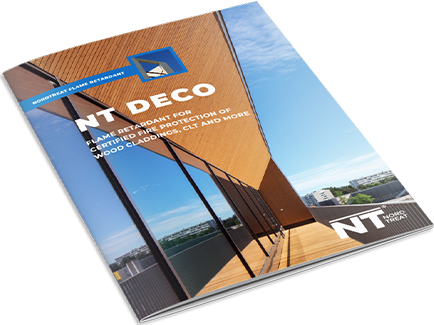
3. FIRE PROTECTION METHODS FOR WOOD PRODUCTS
Wood is at the same time a combustible and fire-safe material. In a fire, untreated wood chars evenly at a rate of about 1 mm per minute, so its performance in a fire can be predicted accurately.
The required fire resistance of wood structures can be achieved by adding the size of the structure, adding a protective cladding, using a non-combustible insulation material and by improving the fire resistance of the wood structure with a flame retardant treatment. Industrial flame retardant treatment can be done by pressure or vacuum technology, by spraying, brushing or dipping.
For interior and exterior wood panels, treatment with flame retardants is the most common way to enhance a product’s fire performance. Besides industrial treatment, the flame retardant can also be applied manually during construction.
READ MORE ABOUT INDUSTRIAL WOOD PRODUCT FIRE PROTECTION METHODS →
INDUSTRIAL FIRE PROTECTION OF WOOD PRODUCTS
Any visible wooden surfaces are subject to the requirements of fire class B-s1 d0 in many buildings. The most prudent way of meeting the requirement is to select industrially fire protected wood products that are installation-ready. This makes it easier to verify the fire class compliance of the surface material, eliminates the need for time and manpower-consuming extensive on-site treatment work and ensures that the final product is consistent in terms of colour tone and quality.
READ MORE ABOUT THE DIFFERENCE BETWEEN INDUSTRIAL TREATMENT AND ON-SITE TREATMENT →
ON-SITE FIRE PROTECTION OF WOOD PRODUCTS
The most common reason for manual fire protection treatment during construction is that suitable industrially treated products are not available. The need for fire protection may also become apparent only during construction.
Only non-toxic flame retardants that are safe for human health and the environment, e.g. NT DECO, are suitable for on-site use. This ensures that the storage, use of the products as well as cleaning of the construction site is safe and does not involve unnecessary risks.
READ MORE ABOUT ON-SITE FIRE PROTECTION →
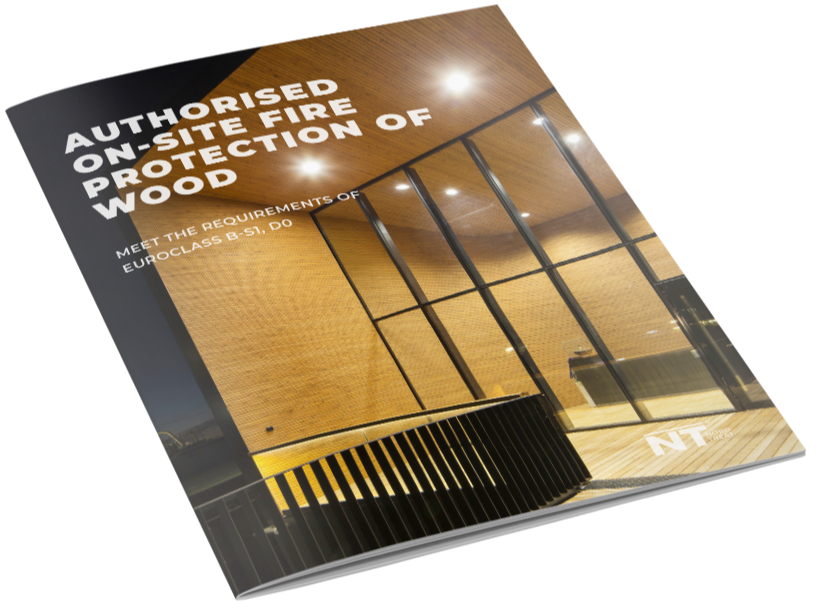
FIRE PROTECTION AND CONSTRUCTION EFFICIENCY
Demand for timber construction technologies and installation-ready products is developing rapidly. Using installation-ready treated wood products and wall and spatial elements speeds up the construction process and helps eliminate risks, because there are less work phases to be carried out on-site.
READ MORE ABOUT FIRE PROTECTION AND CONSTRUCTION →
4. FLAME RETARDANTS FOR WOOD PRODUCTS
Flame retardants are substances that are used for slowing or stopping the spread of fire or reducing its intensity. Flame retardants also prevent the formation of smoke during a fire. Their operation is commonly accomplished by chemical reactions that reduce the flammability or delay the combustion of the protected material. Flame retardants may also cool material through physical action or endothermic chemical reactions.
Wood product flame retardants are available as coatings, including paints, varnishes and stains, as well as pressure treatment products that are designed for industrial use only. Depending on the product, the coating can be applied by spraying, brushing or on a coating line with various brush, vacuum, and spray applicators.
ECO-FRIENDLINESS OF FLAME RETARDANTS
The use of wood in construction is becoming more prevalent thanks to its many benefits, but also because the construction industry is embracing an approach that is more in line with the principles of sustainability. People want to live and work in aesthetically pleasing, eco-friendly and safe buildings. Current technology makes it possible to offer non-toxic flame retardants without compromising functionality. Choosing non-toxic retardants is a vote for the environment, human health and safety.
Traditionally, many industrial treatment methods have contained substances that are harmful to humans, animals and/or the environment, such as boric acid, boron, bromides, formaldehyde and ammonia. Not only is wood treated with such substances prone to emissions throughout its lifecycle, it also slows down construction, as the products require specific coatings, which delays the overall process and leads to higher costs.
Nordtreat’s flame retardants are water-based and pH neutral, containing only patented, food safe compounds and non-toxic additives. As the retardant is absorbed into the wood to a depth of 2 to 3 mm, it forms a breathable membrane, improving the durability of the coating while making it easier to clean the surfaces. The solutions affect the pyrolysis of wood by creating a protective layer of char. The treated wood releases water vapour while burning, which decreases the combustion temperature, slowing the spread of fire.
Ideally, flame retardants can improve the characteristics of wood, for example by protecting it from the effects of sunlight and weathering as Nordtreat products do.
READ MORE ABOUT ECO-FRIENDLY FLAME RETARDANTS →
INDOOR EMISSIONS OF FLAME RETARDANTS
For indoor surfaces or other visible wooden interior surfaces that require fire protection, the safest solution in terms of indoor air quality is to go for a non-toxic retardant with the least amount of emissions. Low emissions are verified by testing the VOC (Volatile Organic Compounds) emissions of the product.
The best emission class in Finland is M1, which Nordtreat’s products are compliant with, including the low emission NT DECO. As the retardant is absorbed into the wood, it forms a breathable membrane, which makes it easier to clean the surface, if necessary.
READ MORE ABOUT HOW FIRE-PROTECTED WOOD AFFECTS INDOOR AIR QUALITY →
5. MANUFACTURING FIRE-PROTECTED WOOD PRODUCTS
Industrial flame retardant treatment can be applied on wood panels with pressure, vacuum, spraying, painting or by immersing the wood product in the retardant.
Wood products manufactured with Nordtreat’s flame retardants are genuinely installation-ready, requiring no further treatment during construction. The need and frequency of re-treatment depend on the location of the timber structure in the building.
Industrial flame retardant treatment can be included in the product certification (CE/ETA) of a wood product. Nordtreat provides guidance to wood product manufacturers and coating companies in flame retardant certification processes. This allows manufacturers to launch fire protected, installation-ready wood products.
READ MORE ABOUT INDUSTRIAL FIRE PROTECTION OF WOOD →
SAFE PRODUCTION AND STORAGE
It is important to ensure occupational safety and health both in production and on construction sites. Chemicals have a role to play in occupational safety and fluidity of operations.
Non-toxic, pH neutral and solvent-free flame retardants are safe to handle and use. These substances also make it faster to clean product lines and tools.
Handling Nordtreat’s products in an industrial environment or a construction site requires the use of common protective equipment. The products can also be stored in normal storage conditions.
READ MORE ABOUT THE BENEFITS OF NON-TOXIC FLAME RETARDANTS →
PRODUCT DEVELOPMENT AND CERTIFICATION OF FLAME RETARDANTS
The growth of industrial timber construction depends on the availability of sustainable and eco-friendly solutions for fire protecting wood. The sector is indeed developing rapidly, and Nordtreat maintains close cooperation with leading research institutes, universities and manufacturers.
Wood product flame retardant certification is practically a prerequisite for indicating that industrial fire protection processes are compliant with relevant quality requirements. It is also recommended to complete CE certification in cooperation with the flame retardant manufacturer.
FIRE-PROTECTED TIMBER CONSTRUCTION PRODUCTS
CE-marked and installation-ready class B-s1 d0 fire protected wood products are available from many manufacturers. Such products include, for example, interior and exterior panels made from various types of wood.
There are also industrially fire protected massive wood products, including CLT and LVL elements and glulam beams.
READ MORE ABOUT FIRE-PROTECTED WOOD PRODUCTS →
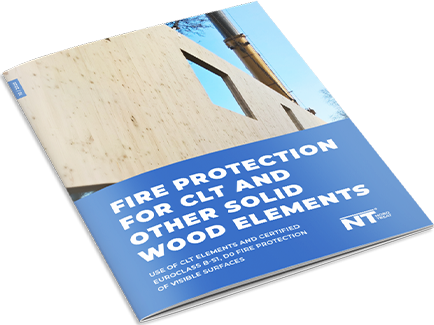
6. DURABILITY OF FIRE PROTECTION TREATMENT
The effectiveness of fire protection treatment depends on the flame retardant, treatment method and treatment conditions. The most simple and secure way is to choose industrially flame retardant treated wood products from a certified supplier. However, not only should the designers be mindful of the fire class of the installation, but observe aspects related to the long-term life cycle of the product as well.
For example, certified wood products treated with NT DECO will maintain their fire protection properties in indoor use throughout the life cycle of the building, unless the wood products are mechanically damaged.
Products used outdoors will require re-treatment after 5 to 15 years depending on exposure to weather conditions. Nordtreat’s flame retardant re-treatment can be applied by spraying or with a roller or a brush according to maintenance instructions.
Wood products treated with Nordtreat flame retardants do not contain harmful substances, which means that the products can be recycled as untreated wood products.
READ MORE ABOUT THE DURABILITY OF FIRE PROTECTION →
7. APPEARANCE OF FIRE-PROTECTED WOOD
Flame retardants for wood are available in covering paints and in translucent (clear or toned) stains. The fire performance of these options depends on the chosen flame retardant and treatment method.
Wood is used in construction due to its many benefits. One of these is the versatility that the grain of various wood types offers. They provide natural variation for the visible surfaces.
The flame retardant can significantly impact the appearance of the wood product. When the visual appearance of natural wood with grains is preferred, translucent flame retardant is the right choice. The coating can be clear or toned. Both options allow for the natural characteristics of the material to shine through. The clear option keeps the natural colour of the wood while toned offers unlimited options for design with colour.
The wood product can also be coated with flame retardant paint, but this typically requires re-treatment during installation or shortly afterwards.
TRANSLUCENT FLAME RETARDANTS
The new generation translucent flame retardants are safe and eco-friendly. NT DECO is available in clear format and in thousands of tones. These products are perfect for fire protecting visible wooden interior and exterior surfaces, including fences, balconies, visual barriers and wall frames.
FIND OUT MORE ABOUT NT DECO FLAME RETARDANT →
VISUAL OPTIONS FOR FLAME RETARDANT
NT DECO can be produced exactly in the right tone. The Nordic Hues collection contains our most popular tones. Architects, designers, wood product manufacturers and construction companies can order samples from this palette or in any other colour.
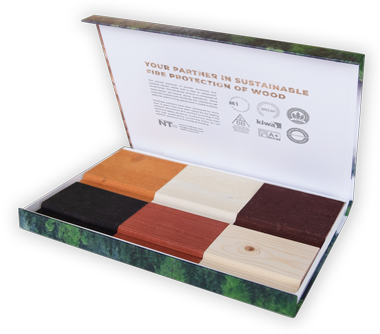
EXAMPLES OF FIRE-PROTECTED WOOD BUILDINGS
Thousands of buildings in several countries have been fire protected with Nordtreat’s products.
SEE OUR REFERENCES →
FLAME RETARDANT PAINTS AND STAINS
If desired, the grain of the wood can be covered with flame retardant paint. Flame retardants are typically compliant with the requirements of Euro class B-s1 d0 when applied with certified industrial processes. Flame retardant paints may also contain substances that protect the wood from mould and fungi. Light wooden surfaces can be also protected with a flame retardant stain, which allows for the natural tones and grain of the wood to shine through.
Flame retardant paints and stains based on different chemical compositions and effects are readily available on the market. These substances are typically suitable for certified industrial processes.
8. MORE INFORMATION ON FIRE PROTECTION OF WOOD PRODUCTS
Requirements for the fire protection of wood are evolving, and flame retardants and fire protection methods are developing rapidly. Contact Nordtreat’s technical support for more information on eco-friendly flame retardants or certification of industrial fire protection processes.
READ MORE ABOUT NORDTREAT →

